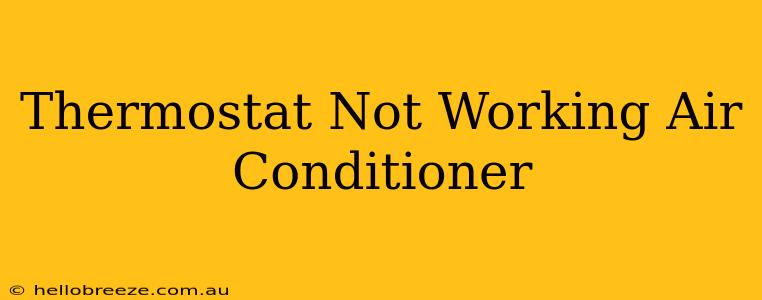Is your air conditioner refusing to cooperate, leaving you sweating in the summer heat? A malfunctioning thermostat is a common culprit. This comprehensive guide will walk you through troubleshooting why your thermostat might not be working with your air conditioner and provide effective solutions to get your cool air flowing again.
Identifying the Problem: Thermostat or AC Unit?
Before diving into thermostat troubleshooting, it's crucial to determine if the problem truly lies with the thermostat itself or your air conditioning unit. Here's how to differentiate:
1. Check the Breaker: A tripped breaker can cut power to your entire AC system, including the thermostat. Check your home's electrical panel for any tripped breakers.
2. Listen for the AC Unit: If the thermostat seems to be receiving power (lights are on, display is working), but you hear no sounds from the outdoor AC unit (compressor, fan), the problem likely lies with the AC unit itself, not the thermostat. You may need a professional AC repair service.
3. Test the Thermostat's Power: If the thermostat display is blank or unresponsive, the problem might be a lack of power to the thermostat itself. Check the wires connecting the thermostat to your electrical system.
Common Thermostat Problems and Solutions
If you've ruled out AC unit issues, here are common thermostat problems and their fixes:
1. Low Batteries (for Battery-Powered Thermostats):
- Problem: The most straightforward issue with battery-powered thermostats is simply low batteries.
- Solution: Replace the batteries with fresh ones of the correct type and voltage. Refer to your thermostat's manual for specifications.
2. Loose Wiring:
- Problem: Loose or disconnected wires prevent proper communication between the thermostat and your AC unit.
- Solution: Carefully inspect the wiring connections at the thermostat. If any wires are loose, gently tighten them using appropriate wire connectors or by carefully twisting the wires together. Caution: Always turn off the power before handling any electrical wiring.
3. Faulty Thermostat:
- Problem: The thermostat itself might be faulty, even if it appears to be working. This could manifest as inaccurate temperature readings, erratic behavior, or complete non-functionality.
- Solution: If you've tried all other troubleshooting steps and the problem persists, the thermostat likely needs to be replaced. Consult the manual for your thermostat model for replacement instructions or contact a professional HVAC technician.
4. Incorrect Settings:
- Problem: Sometimes, the problem is simpler than a malfunction. You might have accidentally changed the thermostat's settings, such as switching it to "off," "heat," or a specific schedule that prevents cooling.
- Solution: Review all the thermostat's settings. Ensure that the system is set to "cool," the temperature is appropriately low, and the fan setting is correct. Check if the system is in "auto" or "on" mode.
5. Programmable Thermostat Issues:
- Problem: Programmable thermostats offer scheduling options, but if the program is set incorrectly or a schedule is preventing operation, cooling might not initiate.
- Solution: Review the programmed schedule to ensure it allows for cooling during your desired hours. You may need to reset the program or adjust individual schedules.
When to Call a Professional
While many thermostat problems can be resolved with simple troubleshooting, some situations require professional assistance:
- Complex Wiring Issues: If you are uncomfortable working with electrical wiring, it's best to leave it to a qualified technician.
- Persistent Problems: If your thermostat continues to malfunction after trying all troubleshooting steps, it is likely defective and needs professional replacement.
- Safety Concerns: Never attempt to repair your AC system if you are unsure of what you are doing, as incorrect repairs can result in electrical shock or further damage.
By following these troubleshooting steps, you can hopefully identify and fix the problem with your thermostat and get your air conditioning back up and running. However, remember that safety is paramount; don't hesitate to call a professional HVAC technician if you are unsure about any aspect of the repair. Staying cool and comfortable should be a priority!

